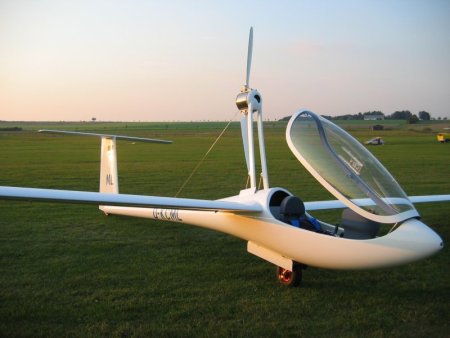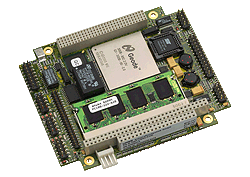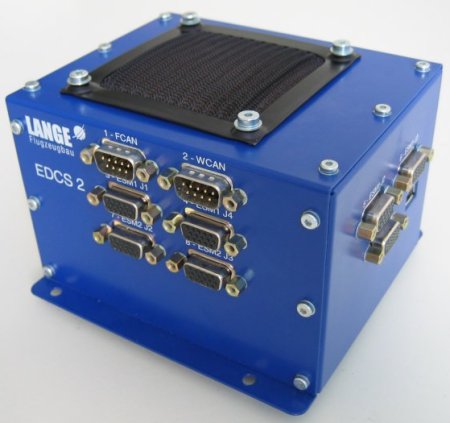Device Profile: Lange-Flugzeugbau Antares self-launching sailplane
Oct 14, 2005 — by LinuxDevices Staff — from the LinuxDevices Archive — 54 views Lange Flugzeugbau GmbH has used embedded Linux to build a battery-propelled self-launching sailplane that it says is more reliable, quieter, and easier to operate than similar gliders powered by combustion engines. The Antares glider uses a Geode-powered PC/104 Linux system for flight control and battery management.
Lange Flugzeugbau GmbH has used embedded Linux to build a battery-propelled self-launching sailplane that it says is more reliable, quieter, and easier to operate than similar gliders powered by combustion engines. The Antares glider uses a Geode-powered PC/104 Linux system for flight control and battery management.
(Click for larger view of Antares in gliding mode)
Lange Flugzeugbau describes the Antares as an “open-class, high-performance sailplane.” It has a wingspan of 65.6 feet (20 meters), is built mainly of carbon fiber composites, and has a survival-zone cockpit “similar to a Formula-1 racing car,” the company says.

The Antares has a “survival zone” cockpit
(Click to enlarge)
The plane has “state-of-the-art aerodynamics and flight dynamics,” and is among the highest-performing sailplanes available today, the company claims. The batteries can drive the plane to heights of 3K meters (about 10,000 feet), at climb rates of 4 meters per second — “Which is quite good actually — on par or better than [self-launching sailplanes with combusion engines],” according to Ola R�er Thorsen, the aerospace engineer responsible for the glider's Linux system.
Lange Flugzeugbau, which employs 40 people, including 30 in manufacturing, expects to produce about 30 Antares gliders this year.

The Antares in climbing mode
The Antares's propulsion system is EASA certified for motorgliders, and is “one-of-a-kind” in the aviation world, according to Thorsen. It is based on a 42-kilowatt brushless motor of the company's own design. The motor has its own controller, which draws power from an 11-kilowatt/hour battery pack comprised of 72 lithium-ion cells.
The battery pack has its own heating system, to ensure optimal power output, along with a network of microcontroller-based modules that closely monitor charge levels. These modules are connected to a central Linux control system using a CAN (controller area network) bus. “All modules are controlled by a central computer, and this is where Linux comes into the game,” Thorsen said.
Battery power, microcontroller modules, and the central Linux computer are also used to retract and extend the propeller and landing gear, and to control other glider functions. The cockpit is equipped with a full-color LCD display, as well as speakers that output audio voice messages. The pilot controls the plane using a patented one-lever control, the company says.
Linux's unique networking capabilities also allowed Lange Flugzeugbau to add some real high-tech magic to the plane — an onboard GSM/GPRS module allows users to monitor their plane's battery charge level via SMS (short message service) messages sent to their mobile phones. The cellular module also allows Lange Flugzeugbau to perform remote diagnostics and firmware updates. “I believe we are one of the very first aircraft ever that have something like this,” Thorsen says.
What's under the, er, cowl?
 The Linux system that controls the Antares is based on a Lippert Cool RoadRunner PC/104 SBC (single-board computer) powered by a 300MHz Geode GX-1 processor. Stacked onto the board are a pair of custom-made add-on cards, along with a 2-port CAN fieldbus card. Thorsen says the company plans to switch to a lead-free Lippert board in the future.
The Linux system that controls the Antares is based on a Lippert Cool RoadRunner PC/104 SBC (single-board computer) powered by a 300MHz Geode GX-1 processor. Stacked onto the board are a pair of custom-made add-on cards, along with a 2-port CAN fieldbus card. Thorsen says the company plans to switch to a lead-free Lippert board in the future.
According to Thorsen, the Linux system that controls the Antares requires less than 32MB of RAM, although the Lippert SBCs come with at least 64MB. The system boots from a CompactFlash disk of unspecified size.
Thorsen says Lange Flugzeugbau uses a custom USB link to program and perform diagnostic operations on the plane. “Custom-made, in order to prevent too much 'hacking' around — it's an aircraft, after all,” says Thorsen.
Thorsen notes that some sensors and modules connect via the RoadRunner's serial and parallel ports. For example, the LCD module — which runs its own software — is controlled via a serial port. Additionally, the RoadRunner's on-board sound is used to create audio voice warning and failure messages in flight.

The Antares's PC/104 board stack is Geode-based
(Click to enlarge)
The Linux environment used in the Antares glider is based on a 2.4-series kernel, along with a “very stripped-down 'linux from scratch' [filesystem],” Thorsen says. The
mgetty open source package is used in the GSM/GPRS communication system, and Lange Flugzeugbau wrote its own Linux driver for the CAN bus.
The environment was created in-house, with help from consultant Karl Osen, who developed the flight systems control software used in the Antares.
Why Linux?
Thorsen says Lange Flugzeugbau originally planned to use QNX, but chose Linux because of the price, and “would definitely stay with Linux now.” He explains, “The advantages are obvious — we can modify or adapt anything we want. And we are starting to know the system well.”
Thorsen notes that Lange Flugzeugbau engineers had to do a lot of reading, initially, to understand how to set up the system, but that “there has never been any serious problems caused by the OS. Mostly, things are solved by searching for hours on Google.”
Thorsen adds that he spent some time making it boot as fast as possible. He thinks boot time can be further improved “if we switch to the 2.6 kernel some time later.”
Special thanks to Thomas Vandekeere for letting us know about the Antares.
Have you heard about a neat use of embedded Linux lately? Let us know!
This article was originally published on LinuxDevices.com and has been donated to the open source community by QuinStreet Inc. Please visit LinuxToday.com for up-to-date news and articles about Linux and open source.